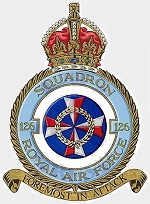Hobby Master HA8320 RAF Supermarine Spitfire Mk. IXc Fighter - ML214, Sqn. Ldr. Johnny Plagis, No.126 Squadron, RAF Harrowbeer Devon, England, August 1944 (1:48 Scale)
"Foremost in attack"
- Motto of No.126 Squadron
 The Spitfire is the most famous British aircraft of all time. Although less numerous than the Hawker Hurricane, it is remembered as the sleek, thoroughbred fighting machine that turned the tide during the Battle of Britain. The Spitfire was among the fastest and most maneuverable prop-driven fighters of World War II, serving in virtually every combat theater.
The Spitfire is the most famous British aircraft of all time. Although less numerous than the Hawker Hurricane, it is remembered as the sleek, thoroughbred fighting machine that turned the tide during the Battle of Britain. The Spitfire was among the fastest and most maneuverable prop-driven fighters of World War II, serving in virtually every combat theater.
Supermarine designer Reginald Mitchell created this small, graceful, elliptical-wing fighter with eight guns in the wings that were able to fire without being hindered by the propeller. The immortal Spitfire thus became not merely one of the best-performing fighters of all time, but also one of the best-looking. Although never employed as a long-range escort, the Spitfire was a champion in an air-to-air duel. Spitfires routinely dived at the speed of sound, faster than any of the German jets.
A carrier-based version, called the Seafire, was a winner in its own right, serving valiantly on convoy routes during World War II. The Seafire 47 was even used in the early stages of the Korean War, before it was replaced by more modern jet aircraft.
Pictured here is a 1:48 scale replica of a RAF Supermarine Spitfire Mk. IXc fighter that was piloted by Squadron Leader Johnny Plagis, who was attached to No.126 Squadron, then deployed to RAF Harrowbeer Devon, England, during August 1944.
Sold Out!
Dimensions:
Wingspan: 9-inches
Length: 7-1/2-inches
Release Date: February 2021
 Historical Account: "Protecting Malta" - No.126 Squadron was a fighter squadron that took part in the defense of Malta in 1941 and 1942, the invasion of Italy in 1943 and the D-Day invasions in 1944.
Historical Account: "Protecting Malta" - No.126 Squadron was a fighter squadron that took part in the defense of Malta in 1941 and 1942, the invasion of Italy in 1943 and the D-Day invasions in 1944.
No.126 Squadron reformed at Talaki on June 28th, 1941, to take part in the defense of Malta. It was equipped with the Hawker Hurricane, and by November was one of three Hurricane squadrons on the island.
In March 1942, a number of Spitfires were flown onto Malta from an aircraft carrier, and some went to No.126 Squadron. By the end of October, three squadrons on Malta had the Spitfire, but the defensive phase of the battle was coming to an end. The defeat of the Afrika Korps after the battle of Alamein and the retreat west across North Africa lifted the siege of Malta, and in 1943 No.126 went onto the offensive, beginning offensive sweeps across Malta in February 1943.
In August 1943, the squadron received a flight of Spitfire IXs, before making the move to Sicily. This was followed by a move onto mainland Italy in October, and over the winter of 1943-44 the squadron operated in support of the Allied armies advancing up the Italian peninsula, before being made non-operational on April 1st, 1944, in preparation for a return to the UK.
The squadron reassembled in the UK in May 1944, now fully equipped with the Spitfire IX. At the end of the month it began operations, providing fighter escort for bombers operation over north-western France and flying patrols over the massive invasion fleet now assembled on the south coast. The squadron continued to provide bomber escorts to the end of the war, moving to East Anglia in August 1944 to be closer to most targets, and receiving the long range Mustang in December 1944.


